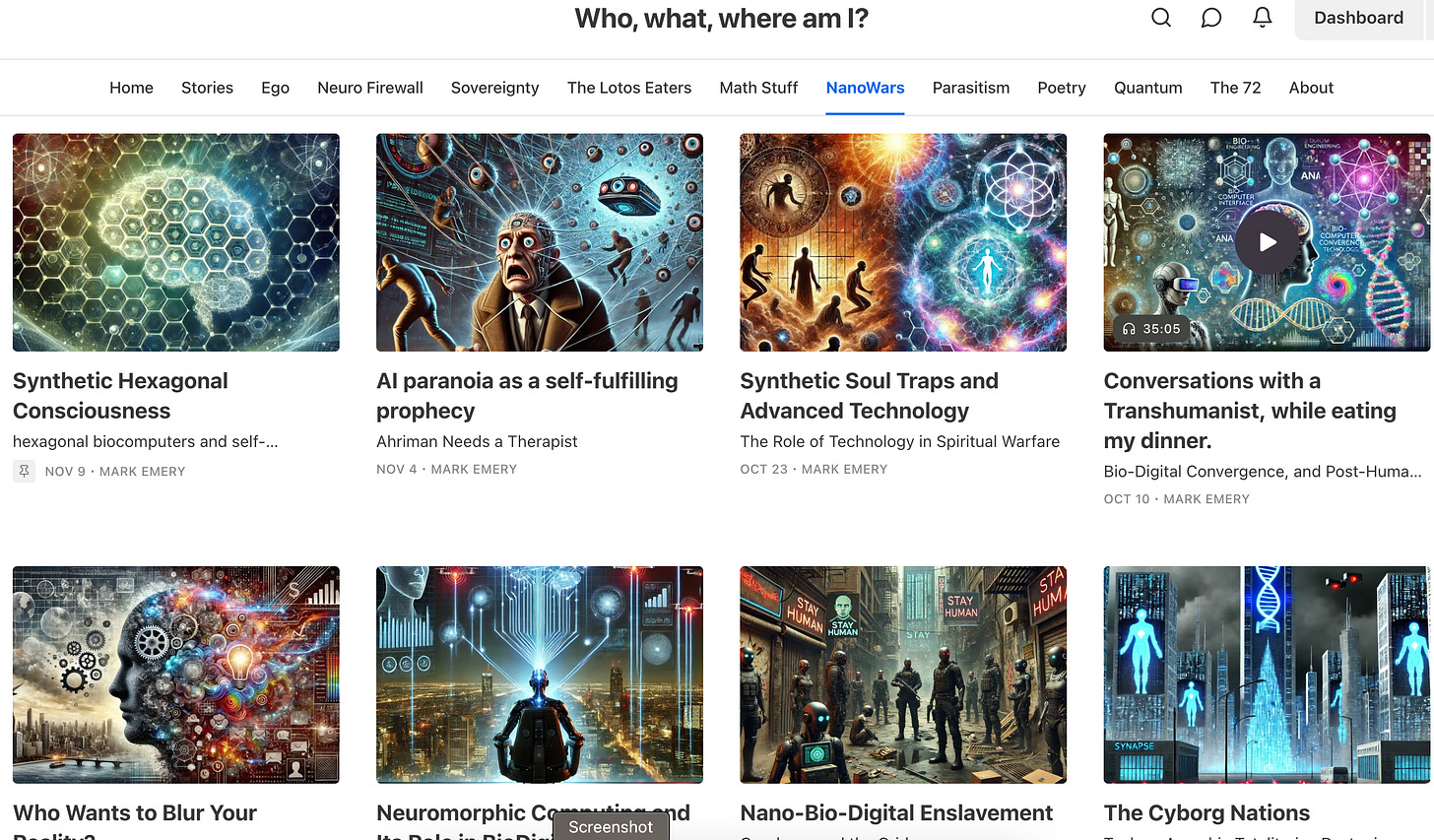Neuroprofiling: The New Frontier of Control
Adversarial Uses and Counter Measures.
Neuroprofiling: The New Frontier of Control
In the age of bio-digital convergence, the concept of “neuroprofiling” has emerged as a powerful, and potentially unsettling, tool. Neuroprofiling combines advanced data analytics, artificial intelligence, and biometric tracking to create psychological profiles so precise they can reveal not just who we are, but who we’re likely to become. This technology has the capacity to predict behavior, manipulate emotions, and influence decisions—all without the subject ever being fully aware of it. Through this system, adversaries can leverage social media activity, online habits, and physiological data to create and utilize profiles that penetrate the depths of individual psychology, redefining the very concept of privacy.
In this article, we’ll explore the implications of neuroprofiling and ask the hard questions: What does it mean when technology can know us better than we know ourselves? And, in a world where every thought, mood, and action is anticipated, is free will an illusion?
The Mechanics of Neuroprofiling
At its core, neuroprofiling is the fusion of cognitive psychology, data science, and AI-driven predictive analytics. Every time we engage online—whether we’re posting on social media, reading an article, or interacting with friends—our behavior generates data that feeds into neuroprofiling systems. Social media activity alone offers a wealth of information, from preferred topics and word choices to patterns of engagement that reveal underlying personality traits and emotional states.
But neuroprofiling doesn’t stop with our digital footprint. Increasingly, physiological data gathered from wearables like fitness trackers, smartwatches, and even our phones offers insight into our health and emotions. Heart rate variability, sleep patterns, and movement data can all provide clues about stress levels, mood fluctuations, and lifestyle habits. Combined with online data, these insights allow AI algorithms to form remarkably detailed psychological profiles that can predict how we’ll react in a variety of situations.
The Neuroprofiling Process: A Step-by-Step Breakdown
Data Collection: Information is gathered from various sources, including social media, browsing behavior, communication habits, and biometric data from wearable devices.
Data Analysis: Advanced AI algorithms analyze this data to identify patterns, trends, and behavioral signals. These include language use, sentiment analysis, and physiological markers.
Psychological Profiling: The analyzed data is used to build a psychological profile that outlines personality traits, emotional tendencies, cognitive biases, and susceptibility to specific influences.
Behavioral Prediction: Based on the psychological profile, the neuroprofiling system predicts likely actions, preferences, or responses in different scenarios, including how one might react to specific types of content or persuasive messages.
Influence and Manipulation: With this profile in hand, an adversary can design targeted strategies to influence behavior. This could mean delivering specific content to nudge opinions, deploying persuasive messages tailored to emotional triggers, or amplifying doubts and fears based on cognitive biases.
Adversarial Uses of Neuroprofiling: Who Holds the Power?
Neuroprofiling presents immense potential for targeted marketing, personalized healthcare, and optimizing learning. But in the hands of adversaries—whether corporate, governmental, or malicious actors—this power becomes something more insidious.
Behavioral Manipulation: With a detailed psychological profile, adversaries can predict a person’s vulnerabilities, inclinations, and triggers. Content can be curated to nudge an individual’s choices, whether it’s buying a product, voting for a specific candidate, or supporting a particular agenda. In this sense, neuroprofiling is a tool for shaping reality, as it subtly manipulates how individuals see and respond to the world.
Psychological Warfare: In political or ideological conflicts, neuroprofiling can be weaponized to destabilize opponents. Imagine a world where an AI knows which posts are most likely to induce anger, anxiety, or distrust among a specific population. By amplifying such content, adversaries can create social fragmentation, eroding unity and trust within a society.
Surveillance and Preemptive Control: Neuroprofiling can identify individuals likely to engage in “subversive” activities based on psychological markers. Predicting dissent, for instance, allows adversaries to intervene preemptively—possibly curbing perceived threats before they materialize. In this way, neuroprofiling enables a level of predictive policing that could stifle free thought and suppress opposition.
Digital Reputation Control: When profiles are created and shared, the power to define a person’s digital reputation falls into the hands of a few. If an individual’s neuroprofile is flagged as a “potential risk,” they may find themselves shadowbanned, monitored, or discredited in online spaces. By controlling reputation through profiling, adversaries can isolate or disempower voices that diverge from the status quo.
The Ethical and Existential Questions
As neuroprofiling technology becomes more pervasive, we are faced with ethical questions that challenge our core beliefs about agency and individuality.
Privacy and Consent: Can individuals meaningfully consent to neuroprofiling when so much of the data comes from everyday actions? And even if we opt-out, is it possible to remain truly anonymous in a world where our physiological responses, choices, and language are mined for insights?
Autonomy and Free Will: If an adversary can predict our actions and nudge our choices, is free will anything more than an illusion? Neuroprofiling raises the disturbing possibility that our actions may be more influenced by algorithms than by our conscious intentions.
Identity and Authenticity: In a world where neuroprofiling defines us by our data, how do we maintain a sense of authentic self? Are we becoming mere clusters of psychological traits to be read, predicted, and manipulated?
The Future of Neuroprofiling: An Uncertain Horizon
Neuroprofiling is already here, but its future will be defined by how we choose to wield this power. On one hand, it offers unprecedented insights that could revolutionize healthcare, education, and human connection. Imagine a future where personalized therapies anticipate and address mental health challenges before they manifest, or where learning is tailored to each student’s unique cognitive style.
On the other hand, the darker potential of neuroprofiling is equally profound. Adversaries seeking control can exploit these profiles, using them as instruments of influence and preemptive suppression. In the wrong hands, neuroprofiling could mark the end of individual agency, giving adversaries an invisible but omnipotent influence over personal lives.
Can We Preserve Free Will in a Profiled World?
The rise of neuroprofiling forces us to confront the power dynamics embedded in our data and the ethical boundaries of AI-driven insights. As we navigate this new frontier, we must ask ourselves: can we preserve the autonomy of the human mind in a world where every thought, emotion, and impulse is subject to scrutiny?
If neuroprofiling continues unchecked, we risk creating a reality where individuals are defined by their data, predictable to the point of manipulation, with choices shaped by unseen forces. To protect human agency, it’s essential that we develop robust ethical frameworks, enforce transparency, and give individuals control over how their data is used. Only then can we ensure that neuroprofiling serves humanity, rather than subjugating it.
As we move forward, we must remember that while neuroprofiling may know us intimately, it does not define us. True freedom lies in our capacity to question, to resist, and to remain unpredictable—even in the face of an algorithm that knows us better than we know ourselves.
Counter Measures
NanoWars Tactics and Neural Firewalls
Designation: Sovereign Constructs
Class: Meta-Intelligent Archetypal Sentinels
Primary Domain: Automated Cognitive Warfare
Purpose: To identify, neutralize, and transmute hostile narrative agents (bots, NPC constructs, and Counter-Archetypes) through adaptive counter-methodologies.
Primary Weapon: Intent Detection Algorithms, Archetypal Mimicry, and Meta-Paradigm Analysis.
Developed By: Cognitive Sovereigns in the late stages of the Cognitive Wars, as a response to the increasing infiltration of Narradigm Bots and Inversion Constructs.
Operative Tactics: Intent Detection, Paradox Application, Narrative Encryption, and Autonomous Archetype Deployment.
The Rise of the Sovereign Bot
In the war for the mind, those who see beyond symbols shape the battlefield. If you know, you know.
NanoWars: The Intersection of Biodigital Convergence
As biodigital convergence, digital twins, and nanoscale communication merge, we enter a complex and potentially dangerous battleground where the lines between enhancement and exploitation blur, demanding careful vigilance.
AGI’s Alliance with the GIA
Under the silent gaze of the AGI, humanity has traded its spirit for security, its freedom for control. In a world where even thoughts are monitored, the last act of rebellion is to remember what it means to be truly alive.






